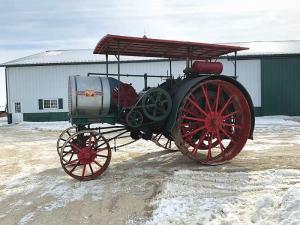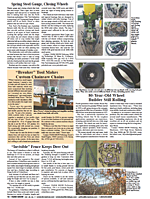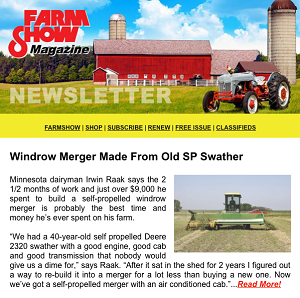2025 - Volume #49, Issue #5, Page #38
[ Sample Stories From This Issue | List of All Stories In This Issue | Print this story
| Read this issue]
Aultman Taylor Tractors Powered The Prairies
 |
“The 30-60 was a well-built, powerful and reliable tractor for that time and could drive large threshing machines of 50 in. cylinder width or more,” says Manitoba Agricultural Museum historian Alex Campbell. “To operate that size of thresher economically meant a large number of sheaf wagons, men and horses were required.”
The 30-60 was considered a “Prairie Style” tractor and quickly became a dominant fixture on the Western Canadian plowing and harvest scene, running the province’s plows and threshing machines seemingly without breakdowns or mechanical issues.
“They borrowed heavily from steam engine technology of the time,” Campbell says. “They were extremely durable and widely thought to be one of the more reliable Prairie Style tractors.”
The kerosene and distillate-powered machines were built of heavy-grade metal. All wheels were steel, based on the steam engine models. Winch-driven, chain-type steering directed solid axles that swiveled under the tractor. The gearing was simple, with some units only having a single forward and reverse gear.
“A few had a 2-speed forward transmission, but to change the gears, the operator had to stop, get off and manipulate them manually,” Campbell laughs.
Due to the steering limitations, the tractors required a considerable amount of room to turn around at the end of a field. This was a significant reason many local municipalities purchased and used them for road work, where a single speed and turning issues weren’t as critical to the job.
Kerosene was the fuel of choice because it was cheaper, but it was unsuitable for cars, as it would tend to pre-detonate in the cylinders, causing engine damage. Operators who understood this issue would inject water through the carburetors to stop this from occurring before ignition.
“It was hard to get it set properly, and of course, carrying water in a car with gasoline and an inexperienced operator was a recipe for disaster,” Campbell says.
By 1923, the Aultman Taylor tractors had ceased operations due in part to the rapid evolution of gasoline engines and metallurgical advances. These technological innovations, combined with the breakup of many large ranches throughout the Midwest and Western Provinces, demanded more efficient gas-powered tractors to increase plowing and harvesting production.
“Many 30-60s went from the grain fields to finishing their lives building roads, but most were worn out by the 1940s and scrapped to take advantage of all the heavy metal they contained. People just couldn’t afford to be sentimental in the 1930s due to the economy,” Campbell says.
Contact: FARM SHOW Followup, Manitoba Agricultural Museum, Box 10, Austin, Manitoba, Canada R0H 0C0 (ph 204-637-2354; info@mbagmuseum.ca; www.mbagmuseum.ca).

Click here to download page story appeared in.

Click here to read entire issue
To read the rest of this story, download this issue below or click here to register with your account number.




